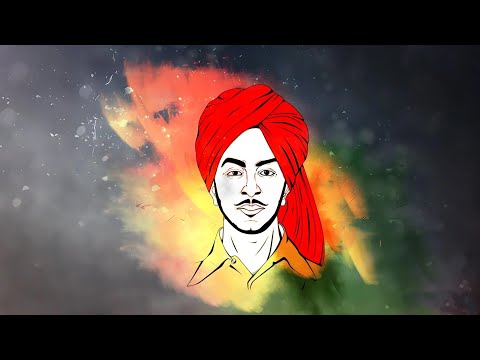 Bhagat Singh (24 September 1906 – death: 23 March 1931) was a great freedom fighter revolutionary of India. He Together with Chandrashekhar Azad and other party members, he fought the mighty British government with unprecedented courage for the independence of the country. The murder of Saunders first in Lahore and then the bombing of the Central Parliament of Delhi (Central Assembly) gave rise to an open revolt against the British Empire.
Bhagat Singh (24 September 1906 – death: 23 March 1931) was a great freedom fighter revolutionary of India. He Together with Chandrashekhar Azad and other party members, he fought the mighty British government with unprecedented courage for the independence of the country. The murder of Saunders first in Lahore and then the bombing of the Central Parliament of Delhi (Central Assembly) gave rise to an open revolt against the British Empire.
He also refused to run away by throwing a bomb in the assembly. As a result, he was hanged on 23 March 1931 along with his two other companions, Rajguru and Sukhdev. The whole country remembered his sacrifice very seriously.
Table of Contents
Birth and Early Life of Bhagat Singh
Bhagat Singh Sandhu was born on September 24, 1908, but according to many evidences of the time, he was born on October 19, 1907. [a] His father’s name was Sardar Kishan Singh Sandhu and mother’s name was Vidyavati Kaur. It was a Jat family. The Jallianwala Bagh massacre on 13 April 1919 in Amritsar had a profound impact on Bhagat Singh’s thinking.
Bhagat Singh had founded the Naujawan Bharat Sabha for the independence of India, leaving the study of the National College of Lahore. In the Kakori case, Bhagat Singh was so much engrossed by the hanging of seven revolutionaries including Ram Prasad ‘Bismil’ and imprisonment on 18 others that Pandit Chandrashekhar Azad joined his party Hindustan Republican Association and gave him a new name Hindustan Socialist Republican Association.
The purpose of this organization was to create youth who could endure service, sacrifice and suffering. Bhagat Singh, along with Rajguru, killed British officer JP Sanders, who was Assistant Superintendent of Police in Lahore on 14 December 1926. In this action, revolutionary Chandrashekhar Azad fully assisted him.
Bhagat Singh, along with revolutionary partner Batukeshwar Dutt, threw bombs and leaflets on 7 April 1929 to awaken the British government in the Parliament House of the then Central Assembly of British India in present day New Delhi. After throwing the bomb, both of them also gave their arrest.
Revolutionary activities of Bhagat Singh
Bhagat Singh was around twelve years old when the Jallianwala Bagh massacre took place. On receiving this information, Bhagat Singh walked 12 miles from his school and reached Jallianwala Bagh. At this age, Bhagat Singh used to read the revolutionary books of his uncles and wondered whether their path was right? After the non-cooperation movement of Gandhiji broke, he started to choose for himself from the non-violent ways of Gandhiji and the violent movement of revolutionaries.
Due to the cancellation of the non-cooperation movement of Gandhiji, there was a little anger in him, but like the whole nation, he also respected Mahatma Gandhi. But he did not consider it unfair to adopt the path of violent revolution for the freedom of the country instead of Gandhiji’s non-violent movement. He started participating in the processions and became a member of many revolutionary parties.
Among the prominent revolutionaries of his party were Chandrashekhar Azad, Sukhdev, Rajguru etc. In Kakori Kand, 6 revolutionaries were hanged and 18 others were sentenced to imprisonment, Bhagat Singh was so much agitated that he merged his party Naujawan Bharat Sabha into Hindustan Republican Association in 1926 and gave it a new name Hindustan Socialist Republican Association.
Retaliation of Lala ji’s death
In 1926, there were terrible demonstrations for the boycott of the Simon Commission. The British government also lathi charged those who participated in these demonstrations. Lala Lajpat Rai died after being hurt by this lathi charge. He is no longer with them. As part of a secret plan, he conceived a plan to kill Police Superintendent Scott. As per the planned plan Bhagat Singh and Rajguru started walking in a busy position in front of Lahore Kotwali. On the other hand, Jaigopal sat with his bicycle as if it had deteriorated. Both became alert at Gopal’s behest. On the other hand, Chandrashekhar Azad was working as a guard in hiding the incident near the boundary of the D.A.L.V. school nearby.
On December 14, 1924, at about four-and-a-quarter past four, as soon as ASP Saunders arrived, Rajguru shot a bullet directly into his head, immediately after which he lost consciousness. After this, Bhagat Singh fired 3-4 shots and made complete arrangements for his death. As both of them were running away, a constable Chanan Singh started chasing them. Chandrashekhar Azad cautioned him – “If I go ahead I will shoot.” Azad did not believe him and shot him. In this way these people avenge the death of Lala Lajpat Rai.
Bomb throwing in assembly
Although Bhagat Singh was not in favor of bloodshed, he believed in leftist ideology, and was related to the principles of Karl Marx and he was advancing the same ideology. However, he was also a strong feeder of socialism. In the past, there have been allegations of tricking the youth in the name of Bhagat Singh by telling them their ideology by their opponents.
Despite Congress being in power, Bhagat Singh did not get the status of Congress martyr, as he only used Bhagat Singh’s name to connect the youth with his party. He did not like the policy of the capitalists to exploit the workers. At that time, since the British were the only surveyors and very few Indian industrialists were able to make progress, their opposition to atrocities against the British workers was natural.
It was their group’s decision not to let the anti-labour policies be passed in the British Parliament. Everybody wanted that the British should know that Hindustani has woken up and there is a resentment towards such policies in their heart. To do so, he had planned to throw a bomb in Delhi Central Assembly.
Jail day of Bhagat Singh
Bhagat Singh remained in prison for nearly 2 years. During this time, he used to write articles and express his revolutionary views. His studies continued even while in jail. His articles written during that time and letters written to his relatives are still mirrors of his thoughts. In his articles, he has described the capitalists as his enemy in many ways. He wrote that even if an Indian, who exploits the workers, is an enemy, he is their enemy.
He also wrote an article in English in jail titled Why am I an atheist? In prison, Bhagat Singh and his colleagues went on hunger strike for 7 days. One of his companions, Yatindranath Das, gave up his life in a hunger strike.
Hanging
On August 26, 1930, the court convicted Bhagat Singh under sections 129, 302 of the Indian Penal Code and sections 4 and 6F of the Explosive Substances Act and section 120 of the IPC. On October 7, 1930, the court gave a 68-page judgment in which Bhagat Singh, Sukhdev and Rajguru were sentenced to death.
Section 144 was imposed in Lahore with the execution of the sentence. After this, an appeal was filed in the Privy Council for the forgiveness of Bhagat Singh’s hanging but this appeal was canceled on 10 January 1931. After this, the then Congress President Pt Madan Mohan Malviya filed an appeal before the Viceroy on 14 February 1931 for forgiveness of sentence, using his privilege to waive his death sentence on the basis of humanity.
Mahatma Gandhi spoke to the Viceroy on 17 February 1931 to pardon the death sentence of Bhagat Singh, then on 18 February 1931, on behalf of the general public, filed an appeal for waiver with various arguments before the Viceroy. All this was happening against the wishes of Bhagat Singh because Bhagat Singh did not want his sentence to be forgiven.
On 23 March 1931, Bhagat Singh and his two companions Sukhdev and Rajguru were hanged at around 7.33 pm in the evening.
It is said that when the jail authorities informed them that the time had come for their execution, they had said – “Stop! First, get a revolutionary from another.” Then a minute later the book leapt towards the ceiling and said – “Okay now let’s go.”
While going to the gallows, the three were singing with joy –
mera rang de basantee chola, mera rang de.
mera rang de basantee chola. maay rang de basantee chola.
